tow SKODA SUPERB 2009 2.G / (B6/3T) Repair Manual
[x] Cancel search | Manufacturer: SKODA, Model Year: 2009, Model line: SUPERB, Model: SKODA SUPERB 2009 2.G / (B6/3T)Pages: 294, PDF Size: 21.33 MB
Page 206 of 294
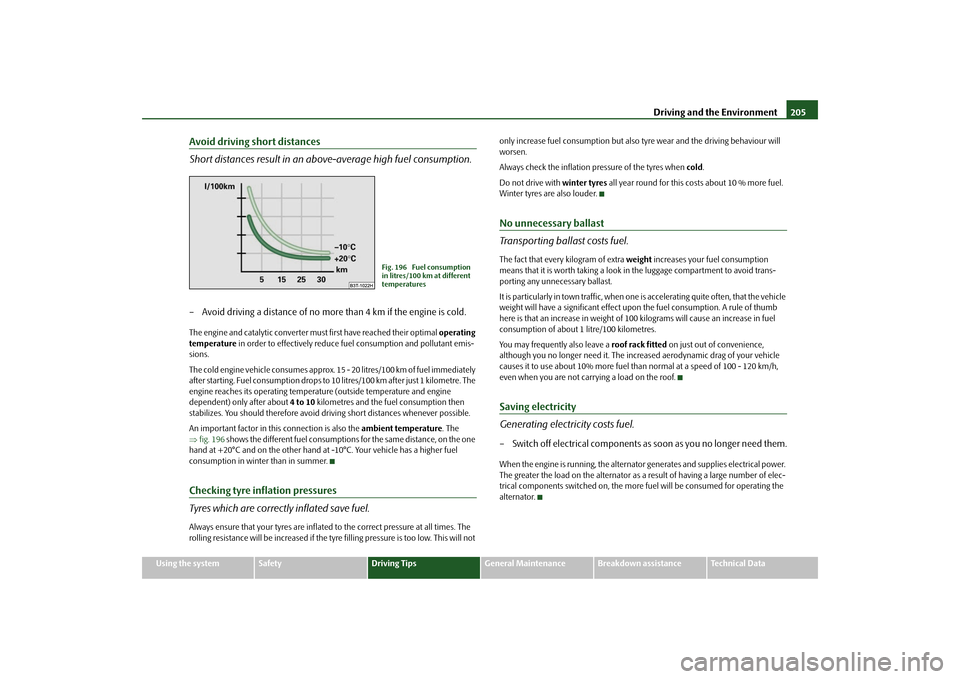
Driving and the Environment
205
Using the system
Safety
Driving Tips
General Maintenance
Breakdown assistance
Technical Data
Avoid driving short distances Short distances result in an above-average high fuel consumption.– Avoid driving a distance of no more than 4 km if the engine is cold.The engine and catalytic converter mu
st first have reached their optimal
operating
temperature
in order to effectively reduce fu
el consumption and pollutant emis-
sions. The cold engine vehicle consumes approx. 15 - 20 litres/100 km of fuel immediately after starting. Fuel co
nsumption drops to 10 litres/100 km after just 1 kilometre. The
engine reaches its operating temperat
ure (outside temperature and engine
dependent) only after about
4 to 10
kilometres and the fuel consumption then
stabilizes. You should therefore avoid driving short distances whenever possible. An important factor in this connection is also the
ambient temperature
. The
⇒ fig. 196
shows the different fuel consumptions for the same distance, on the one
hand at +20°C and on the other hand at
-10°C. Your vehicle has a higher fuel
consumption in winter than in summer.Checking tyre inflation pressures Tyres which are correctly inflated save fuel.Always ensure that your tyres are inflated
to the correct pressure at all times. The
rolling resistance will be increased if the tyre filling pressure is too low. This will not
only increase fuel consumption but also
tyre wear and the driving behaviour will
worsen. Always check the inflation pressure of the tyres when
cold
.
Do not drive with
winter tyres
all year round for this costs about 10 % more fuel.
Winter tyres are also louder.No unnecessary ballast Transporting ballast costs fuel.The fact that every kilogram of extra
weight
increases your fuel consumption
means that it is worth taking a look in the luggage compartment to avoid trans- porting any unnecessary ballast. It is particularly in town traffic, when one
is accelerating quite often, that the vehicle
weight will have a significant effect upon
the fuel consumption. A rule of thumb
here is that an increase in weight of 100
kilograms will cause an increase in fuel
consumption of about 1
litre/100 kilometres.
You may frequently also leave a
roof rack fitted
on just out of convenience,
although you no longer need it. The incr
eased aerodynamic drag of your vehicle
causes it to use about 10% more fuel th
an normal at a speed of 100 - 120 km/h,
even when you are not carr
ying a load on the roof.
Saving electricity Generating electricity costs fuel.– Switch off electrical components as
soon as you no longer need them.
When the engine is running, the alternator
generates and supplies
electrical power.
The greater the load on the alternator as a result of having a large number of elec-trical components switched on, the more
fuel will be consumed for operating the
alternator.
Fig. 196 Fuel consumption in litres/100 km at different temperatures
s2dk.1.book Page 205 Wednesday, April 8, 2009 12:23 PM
Page 209 of 294

Towing a trailer
208
Towing a trailerTo w i n g a t r a i l e rTechnical requirements The towing device must satisfy
certain technical requirements.
Your vehicle is designed primarily for tr
ansporting persons and luggage. It can,
however, also be used for towing a traile
r - provided certain te
chnical equipment is
fitted. If your vehicle has already been supplied with a
factory-fitted
towing device then
everything that is necessary
for towing a trailer in technical terms, and in terms of
the law, has already been taken into account. Your vehicle is fitted with a 13-pin po
wer socket for the electrical connection
between the vehicle and trailer. If th
e trailer which you wish to tow has a
7-pin
connector
, you can use a suitable adapter
15) from Škoda original accessories.
This work must be carried out in accordan
ce with the manufacturer's specifications
if a towing device is retrofitted. Authorised Škoda Service Partners are familiar with details relating to retrofitting a towing device and for any necessary
modifications to the cooling system.
WARNING
We recommend that you have the towing device from Škoda original acces- sories installed by an authorised Škoda Service Partner. He is familiar with all the relevant details relating to retrofitting such equipment. There is a risk of an accident if the towing device is not properly fitted!
General Maintenance There are a number of points to
pay attention to when towing a
trailer.Trailer load The permissible trailer load must
on no account be exceeded.
You can negotiate appropriatel
y steeper inclines and desc
ents if you do not make
full use of the perm
issible trailer load.
The trailer loads specified only apply for
altitudes
up to 1 000 metres above mean
sea level. The fact that the engine power ou
tput drops with increasing height due to
a lowering of air pressure and thus the abil
ity to climb, means that the towed weight
must be reduced by 10% for every further increase of 1 000 metres in height above sea level. The towed weight is the weight of the (laden) vehicle and the (laden) trailer together. One should take this into account before driving up to higher alti- tudes. The trailer and drawbar load information on the type plate of the towing device are merely test data for the tow
ing device The data relating to your
vehicle, which is often less than this test data, can be found in your vehicle registration documents. Distribution of the load Distribute the load in the trailer in such a way that any heavy items are located as close as possible to the axle. Secure
the items to prevent them slipping.
Tyre inflation pressure Select the tyre inflation pressure on your vehicle for that of “fully laden”, ⇒ page 235. The inflation pressure of the tyres fitted to the trailer adjust in accord- ance with the manufacturer's recommendation. Exterior mirrors You have to have additional
exterior mirrors fitted if you are not able to see the
traffic behind the trailer with the standard rear-view mirrors. Both exterior mirrors
15)In some countries the adapter is
supplied with the towing device.
s2dk.1.book Page 208 Wednesday, April 8, 2009 12:23 PM
Page 210 of 294
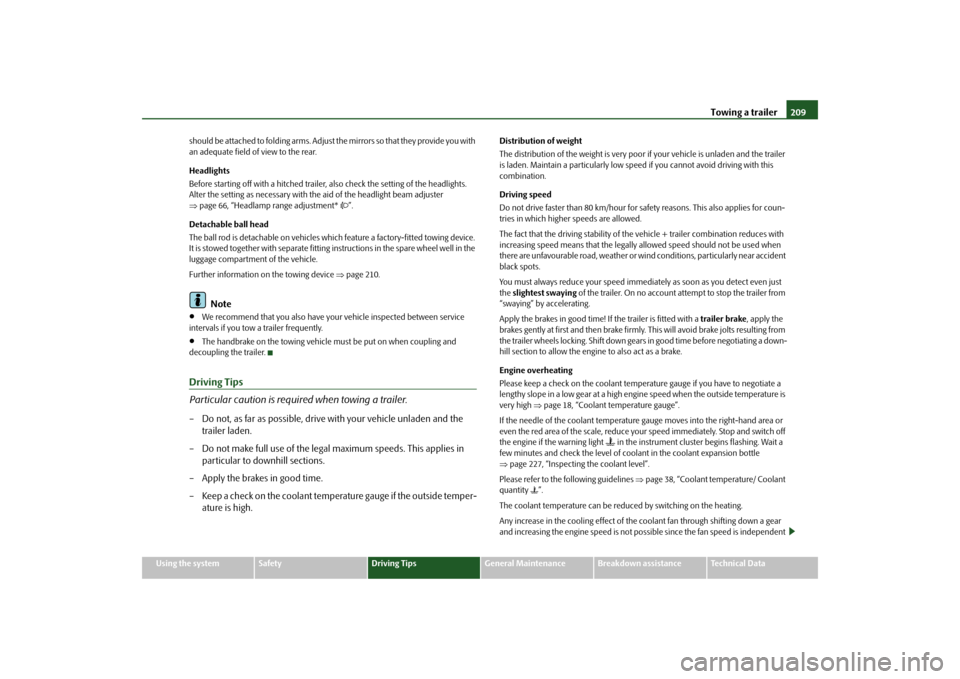
Towing a trailer
209
Using the system
Safety
Driving Tips
General Maintenance
Breakdown assistance
Technical Data
should be attached to folding arms. Adjust
the mirrors so that they provide you with
an adequate field of view to the rear. Headlights Before starting off with a hitched trailer, also check the setting of the headlights. Alter the setting as necessary with th
e aid of the headlight beam adjuster
⇒ page 66, “Headlamp range adjustment*
”.
Detachable ball head The ball rod is detachable on vehicles which feature a factory-fitted towing device. It is stowed together with separate fitting instructions in the spare wheel well in the luggage compartment of the vehicle. Further information on the towing device
⇒page 210.
Note
•
We recommend that you also have yo
ur vehicle inspected between service
intervals if you tow a trailer frequently.•
The handbrake on the towing vehicle
must be put on when coupling and
decoupling the trailer.Driving Tips Particular caution is required when towing a trailer.– Do not, as far as possible, drive
with your vehicle unladen and the
trailer laden.
– Do not make full use of the legal maximum speeds. This applies in
particular to downhill sections.
– Apply the brakes in good time.– Keep a check on the coolant temper
ature gauge if the outside temper-
ature is high.
Distribution of weight The distribution of the weight is very poor
if your vehicle is
unladen and the trailer
is laden. Maintain a particularly low speed if you cannot avoid driving with this combination. Driving speed Do not drive faster than 80 km/hour for safety reasons. This also applies for coun- tries in which higher speeds are allowed. The fact that the driving stability of the vehicle + trailer combination reduces with increasing speed means that the legally allowed speed should not be used when there are unfavourable road, weather or wind
conditions, particul
arly near accident
black spots. You must always reduce your speed immedi
ately as soon as you detect even just
the
slightest swaying
of the trailer. On no account attempt to stop the trailer from
“swaying” by
accelerating.
Apply the brakes in good time! If the trailer is fitted with a
trailer brake
, apply the
brakes gently at first and then brake firmly
. This will avoid brake jolts resulting from
the trailer wheels locking. Shift down gears
in good time before negotiating a down-
hill section to allow the engine to also act as a brake. Engine overheating Please keep a check on the coolant temperature gauge if you have to negotiate a lengthy slope in a low gear at a high engine speed when the outside temperature is very high
⇒page 18, “Coolant temperature gauge”.
If the needle of the coolant temperature gauge moves into the right-hand area or even the red area of the scale, reduce yo
ur speed immediately. Stop and switch off
the engine if the warning light
in the instrument cluste
r begins flashing. Wait a
few minutes and check the level of coolant in the coolant expansion bottle ⇒ page 227, “Inspecting the coolant level”. Please refer to the following guidelines
⇒page 38, “Coolant temperature/ Coolant
quantity
”.
The coolant temperature can be reduced by switching on the heating.Any increase in the cooling effect of the coolant fan through shifting down a gear and increasing the engine speed is not possible since the fan speed is independent
s2dk.1.book Page 209 Wednesday, April 8, 2009 12:23 PM
Page 211 of 294

Towing a trailer
210
of the engine speed. One should also not
drop a gear for this reason when towing
a trailer as long as the en
gine can manage the slope
without any drop in speed.
Detachable towing device*The detachable ball head of the towing device
is stowed in a box for the car tool kit
in the spare wheel well in the luggage compartment. An instruction for correct installation an
d removal of the ball head of the towing
device is supplied
with the ball head
Inspect the ball head to ensure that it is pr
operly locked each time before setting off.
The inspection is performed by turning the closed locking lever downwards. If the locking lever can only be turned around a small angle (approx. 5°), the locking mechanism is O.K. After the inspection pull
the locking lever back again to its stop.
The towing device must not be used, if it does not wish to close or the locking lever turns slightly in the closed position.
WARNING
Do not use any aids or tools for installing or removing the ball head. This might result in damage to the locking mechanism to the extent that the safety of the towing device is no longer assured - risk of an accident.
Note
•
Do not carry out any modifications or repairs to the ball head or to any other
components on the towing device.•
Contact a specialist garage if you en
counter any problems using the device.
•
Never unlock the ball head with a trailer coupled to it.
•
You should take off the ball head if you drive without towing a trailer. Inspect
whether the end cover properly seals off the mounting shaft.•
Remove the ball head beforehand if yo
u wish to clean your vehicle using a
steam jet. Ensure that the end cover properly seals the mounting shaft.•
It is recommended to wear gloves
when installing and removing.
Fig. 197 Detachable ball head
s2dk.1.book Page 210 Wednesday, April 8, 2009 12:23 PM
Page 223 of 294

Inspecting and replenishing
222
Inspecting and replenishingEngine compartmentBonnet remote releaseBonnet remote release – Pull the unlocking lever below the
dash panel on the driver's side
⇒
fig. 200
.
The bonnet jumps out of its lock as a result of the spring force.
Opening and closing the bonnet.Opening the bonnet – Unlock the bonnet
⇒
fig. 200
.
– Ensure that the arms of the windsc
reen wipers are correctly in place
against the windscreen
before opening
the bonnet otherwise
damage could occur to the paintwork.
– Press the locking button
⇒
fig. 201
, the bonnet is then unlocked.
– Grasp the bonnet at the bottom part
of the radiator grille and lift it
towards the top so that it is held opened by the gas pressure support.
Closing the bonnet – You can overcome the force of the gas pressure support by pulling the
bonnet towards the bottom.
– Allow the bonnet to drop from a height
of about 30 cm into the lock -
bonnet
do not press down on it
!
Fig. 200 Bonnet release lever
Fig. 201 Radiator grille: Lever of the locking button
s2dk.1.book Page 222 Wednesday, April 8, 2009 12:23 PM
Page 226 of 294

Inspecting and replenishing
225
Using the system
Safety
Driving Tips
General Maintenance
Breakdown assistance
Technical Data
– Wait a few minutes and pull out the oil dipstick. – Wipe off the dipstick with a clea
n cloth and insert it again fully.
– Then withdraw the dipstick ag
ain and read off the oil level.
Oil level within range – You must
not
top up the oil.
Oil level within range – You
may
top up the oil. It is possible that the oil level may then be
within range after doing this.
Oil level within range – You
must
top up the oil
⇒
page 225. It is sufficient, once this is done,
to keep the oil level within range .
It is normal for the engine to consume oi
l. The oil consumption may be as much as
0.5 l/1 000 km depending on your style of
driving and the conditions under which
you operate your vehicle. Th
e oil consumption may be sl
ightly higher than this
during the first 5 000 kilometres. One should therefore check the oil level at regular intervals, preferably every time after the fuel tank is filled or after driving for long stretches. We recommend maintaining the oil level within the range -
but not above this
,
if the engine has been operating at high loads, for example during a lengthy motorway trip during the
summer months, towing a trai
ler or negotiating a high
mountain pass. The warning light in the instrument cluster* will indicate
⇒page 42, “Engine oil
level
” whether the oil level is too low. In this case, check the oil level as soon as
possible. Top up with an appropriate quantity of oil.
Caution
•
The oil level must on no account ex
tend beyond the ra
nge . Danger of
damaging the catalytic converter.
•
Do not continue your journey
if for some reason it is not possible under the
conditions prev
ailing to top up with oil.
Switch of the engine and contact
and
obtain professional assistance from a specialist garage.
Note
Engine oil specifications
⇒page 270.
Replenishing engine oil– Inspecting the engine oil level
⇒
page 224.
– Unscrew the cap of the engine oil filler opening.– Pour in a suitable grade of oil in portions of 0.5 litres
⇒
page 270.
– Inspect the oil level
⇒
page 224, “Check engine oil level”.
– Carefully screw on the cap of the filler opening and push the dipstick
in fully.
WARNING
•
Avoid dripping oil onto hot parts of the engine when topping up will oil -
a risk of fire!•
Read and observe the warning notes
⇒page 223, “Working in the engine
compartment” before working in the engine compartment.
For the sake of the environment
The oil level must on no account be above the range
⇒page 224. Oil will other-
wise be drawn in through the crankcas
e ventilation and may pass through the
exhaust system to atmosphere. The oil ma
y combust in the catalytic converter and
damage it.
AAAB
AA
AC
AB
AA
AA
Aa
s2dk.1.book Page 225 Wednesday, April 8, 2009 12:23 PM
Page 244 of 294

Breakdown assistance
243
Using the system
Safety
Driving Tips
General Maintenance
Breakdown assistance
Technical Data
Breakdown assistanceBreakdown assistanceFirst-aid box*First-aid box The compartment for stowing the first-aid bo
x is located in the right of the luggage
compartment
⇒fig. 213
.
Note
Pay attention to the use-by-date of the contents of the first-aid box.
Warning triangleThe warning triangle can be attached to the
trim panel of the rear wall with rubber
straps
⇒fig. 214
.
Fire extinguisher*The fire extinguisher is attached with straps in a holder under the driver seat. Please read carefully the
instructions which are atta
ched to the fire extin-
guisher. The fire extinguisher must be checked by an authorised person or company annu- ally (please observe the differing legal requirements).
Fig. 213 Compartment for stowing first-aid box
Fig. 214 Placing of the warning triangle
s2dk.1.book Page 243 Wednesday, April 8, 2009 12:23 PM
Page 245 of 294
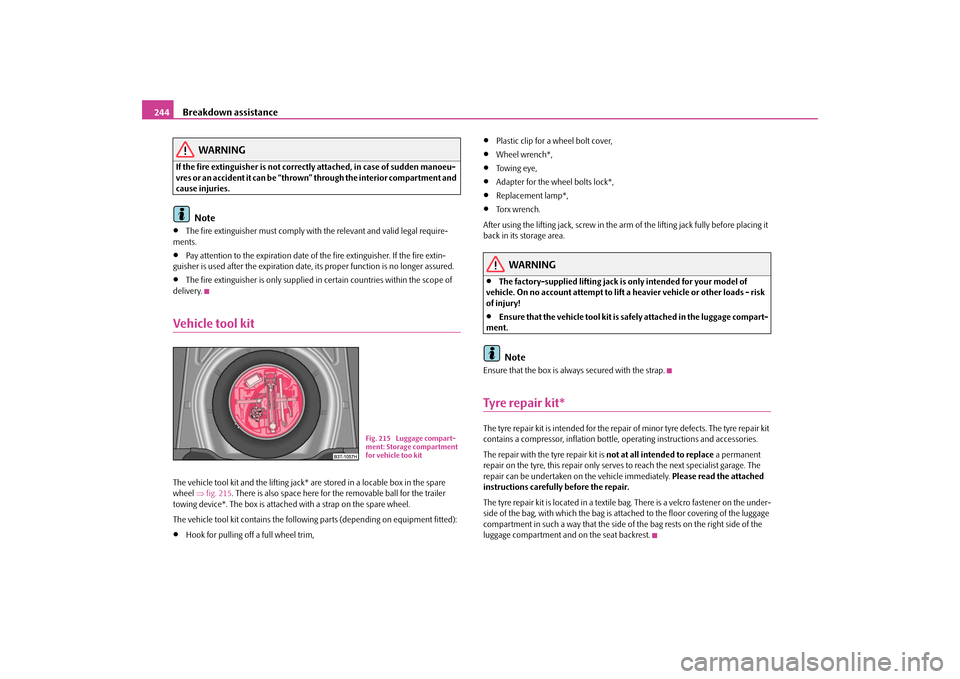
Breakdown assistance
244
WARNING
If the fire extinguisher is not correc
tly attached, in case of sudden manoeu-
vres or an accident it can be “thrown” through the interior compartment and cause injuries.
Note
•
The fire extinguisher must comply with
the relevant and valid legal require-
ments.•
Pay attention to the expiration date of the fire extinguisher. If the fire extin-
guisher is used after the expiration date,
its proper function is
no longer assured.
•
The fire extinguisher is only supplied in
certain countries within the scope of
delivery.Vehicle tool kitThe vehicle tool kit and the lifting jack*
are stored in a locable box in the spare
wheel
⇒fig. 215
. There is also space here for the removable ball for the trailer
towing device*. The box is attached
with a strap on the spare wheel.
The vehicle tool kit contains the following parts (depending on equipment fitted):•
Hook for pulling off a full wheel trim,
•
Plastic clip for a wheel bolt cover,
•
Wheel wrench*,
•
To w i n g e y e ,
•
Adapter for the wheel bolts lock*,
•
Replacement lamp*,
•
Torx wrench.
After using the lifting jack, screw in the arm
of the lifting jack fully before placing it
back in its storage area.
WARNING
•
The factory-supplied lifting jack is only intended for your model of
vehicle. On no account attempt to lift a heavier vehicle or other loads - risk of injury!•
Ensure that the vehicle tool kit is
safely attached in the luggage compart-
ment.
Note
Ensure that the box is alwa
ys secured with the strap.
Tyre repair kit*The tyre repair kit is intended for the repair of minor tyre defects. The tyre repair kit contains a compressor, inflation bottle, operating instructions and accessories. The repair with the
tyre repair kit is
not at all intended to replace
a permanent
repair on the tyre, this repair only serves
to reach the next specialist garage. The
repair can be undertaken on
the vehicle immediately.
Please read the attached
instructions carefully before the repair. The tyre repair kit is located in a textile bag. There is a velcro fastener on the under- side of the bag, with which the bag is atta
ched to the floor covering of the luggage
compartment in such a way that the side of the bag rests on the right side of the luggage compartment and on the seat backrest.
Fig. 215 Luggage compart- ment: Storage compartment for vehicle too kit
s2dk.1.book Page 244 Wednesday, April 8, 2009 12:23 PM
Page 247 of 294
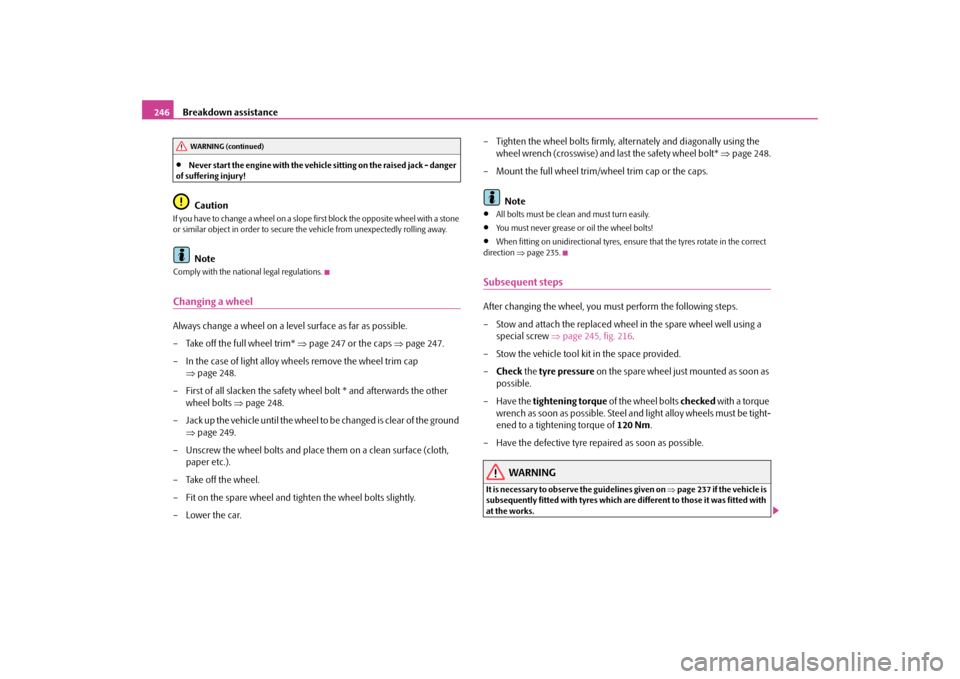
Breakdown assistance
246
•
Never start the engine with the vehicle
sitting on the raised jack - danger
of suffering injury!
Caution
If you have to change a wheel on a slope
first block the opposite wheel with a stone
or similar object in order to secure th
e vehicle from unexpectedly rolling away.
Note
Comply with the national legal regulations.Changing a wheelAlways change a wheel on a level surface as far as possible. – Take off the full wheel trim*
⇒
page 247 or the caps
⇒
page 247.
– In the case of light alloy wheels remove the wheel trim cap
⇒
page 248.
– First of all slacken the safety wh
eel bolt * and afterwards the other
wheel bolts
⇒
page 248.
– Jack up the vehicle until the wheel to
be changed is clear of the ground
⇒
page 249.
– Unscrew the wheel bolts and place them on a clean surface (cloth,
paper etc.).
– Take off the wheel. – Fit on the spare wheel and tighten the wheel bolts slightly. –Lower the car.
– Tighten the wheel bolts firmly, al
ternately and diagonally using the
wheel wrench (crosswise) and last the safety wheel bolt*
⇒
page 248.
– Mount the full wheel trim/w
heel trim cap or the caps.
Note
•
All bolts must be clean
and must turn easily.
•
You must never grease or oil the wheel bolts!
•
When fitting on unidirectional tyres, ensure that the tyres rotate in the correct
direction
⇒page 235.
Subsequent stepsAfter changing the wheel, you must perform the following steps. – Stow and attach the replaced wheel in the spare wheel well using a
special screw
⇒
page 245, fig. 216
.
– Stow the vehicle tool kit in the space provided.–
Check
the
tyre pressure
on the spare wheel just mounted as soon as
possible.
– Have the
tightening torque
of the wheel bolts
checked
with a torque
wrench as soon as possible. Steel and light alloy wheels must be tight-ened to a tightening torque of
120 Nm
.
– Have the defective tyre repaired as soon as possible.
WARNING
It is necessary to observe the guidelines given on
⇒page 237 if the vehicle is
subsequently fitted with tyres which are
different to those it was fitted with
at the works.
WARNING (continued)
s2dk.1.book Page 246 Wednesday, April 8, 2009 12:23 PM
Page 253 of 294
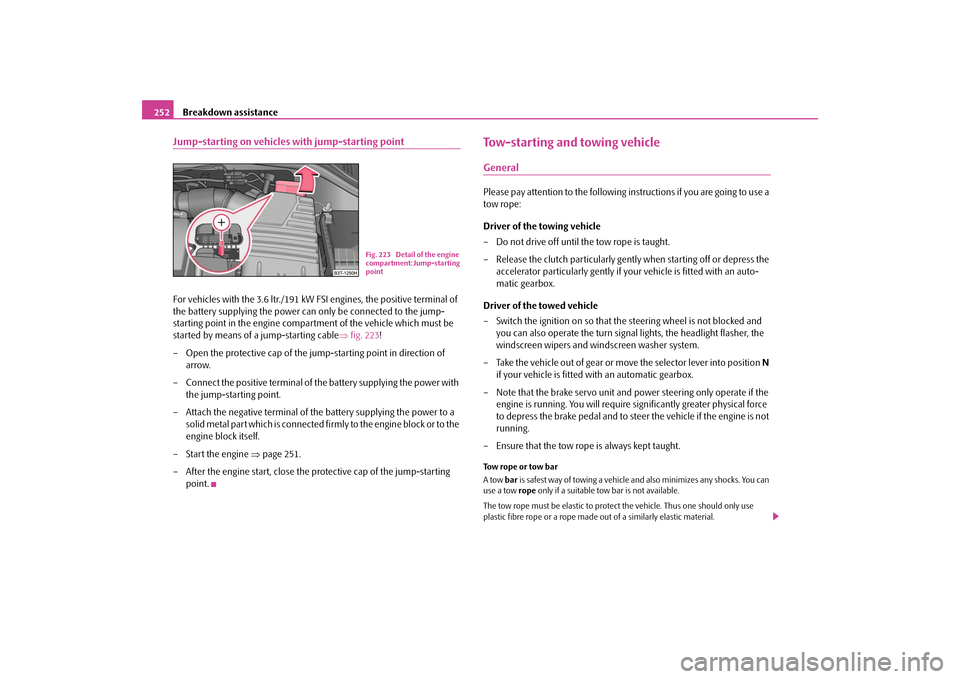
Breakdown assistance
252
Jump-starting on vehicles with jump-starting pointFor vehicles with the 3.6 ltr./191 kW FS
I engines, the positive terminal of
the battery supplying the power can only be connected to the jump-starting point in the engine compartment of the vehicle which must be started by means of a jump-starting cable
⇒
fig. 223
!
– Open the protective cap of the ju
mp-starting point in direction of
arrow.
– Connect the positive terminal of
the battery supplying the power with
the jump-starting point.
– Attach the negative terminal of the battery supplying the power to a
solid metal part which is connected fi
rmly to the engine block or to the
engine block itself.
–Start the engine
⇒
page 251.
– After the engine start, close the
protective cap of the jump-starting
point.
Tow-starting and towing vehicleGeneralPlease pay attention to the following in
structions if you are going to use a
tow rope: Driver of the towing vehicle – Do not drive off until the tow rope is taught. – Release the clutch particularly gent
ly when starting off or depress the
accelerator particularly gently if yo
ur vehicle is fitted with an auto-
matic gearbox.
Driver of the towed vehicle – Switch the ignition on so that th
e steering wheel is not blocked and
you can also operate the turn signal
lights, the headlight flasher, the
windscreen wipers and windscreen washer system.
– Take the vehicle out of gear or move the selector lever into position
N
if your vehicle is fitted
with an automatic gearbox.
– Note that the brake servo unit and po
wer steering only operate if the
engine is running. You will require
significantly greater physical force
to depress the brake pedal and to steer the vehicle if the engine is not running.
– Ensure that the tow rope is always kept taught.Tow rope or tow bar A tow
bar
is safest way of towing a vehicle and also minimizes any shocks. You can
use a tow
rope
only if a suitable tow bar is not available.
The tow rope must be elastic to protect
the vehicle. Thus one should only use
plastic fibre rope or a rope made
out of a similarly elastic material.
Fig. 223 Detail of the engine compartment: Jump-starting point
s2dk.1.book Page 252 Wednesday, April 8, 2009 12:23 PM